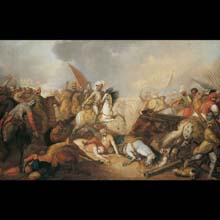
material: oil on canvas
dimensions: 95 x 148 cm
description: The battle of Chocim (Khotyn), which took place in 1673, was one of the most well-known battles in the history of Poland. Great Crown Hetman John Sobieski, the future king, defeated the forces of the Ottoman Empire there. Sobieski employed a stratagem and surprised the enemy, which led to this success. He approached the fortifications of the enemy on November 10, but did not attack immediately. Sobieski and his soldiers were on the alert all night, forcing Turks to stay on the embankments and wait for the attack. The cold weather was more unbearable for them than for the Polish troops, so some of them went to the tents before dawn to get warm and eat something. This is when Sobieski attacked, causing panic among the Turks. Franciszek Smuglewicz depicted the storm of the Polish army, perhaps the moment when some of the escaping Turks attacked Sobieski’s detachment, and the hussars, standing nearby, hastened to help the hetman. Yet, it is not a very accurate representation when it comes to historical facts, weapons and other details. In the late 18th century, the level of historical knowledge was not high yet, and both artists and viewers did not expect an event to be depicted as it really was, but rather in accordance with the principles of appropriateness (decorum), that is depicting a historical event in an “appropriate” way, following the accepted convention of painting a battle. Barbara Ciciora
exposition: The Gallery of 19th Century Polish Art in Sukiennice,
The Cloth Hall, 1, Main Market Square
key: Enlightenment >>>
dimensions: 95 x 148 cm
description: The battle of Chocim (Khotyn), which took place in 1673, was one of the most well-known battles in the history of Poland. Great Crown Hetman John Sobieski, the future king, defeated the forces of the Ottoman Empire there. Sobieski employed a stratagem and surprised the enemy, which led to this success. He approached the fortifications of the enemy on November 10, but did not attack immediately. Sobieski and his soldiers were on the alert all night, forcing Turks to stay on the embankments and wait for the attack. The cold weather was more unbearable for them than for the Polish troops, so some of them went to the tents before dawn to get warm and eat something. This is when Sobieski attacked, causing panic among the Turks. Franciszek Smuglewicz depicted the storm of the Polish army, perhaps the moment when some of the escaping Turks attacked Sobieski’s detachment, and the hussars, standing nearby, hastened to help the hetman. Yet, it is not a very accurate representation when it comes to historical facts, weapons and other details. In the late 18th century, the level of historical knowledge was not high yet, and both artists and viewers did not expect an event to be depicted as it really was, but rather in accordance with the principles of appropriateness (decorum), that is depicting a historical event in an “appropriate” way, following the accepted convention of painting a battle. Barbara Ciciora
exposition: The Gallery of 19th Century Polish Art in Sukiennice,
The Cloth Hall, 1, Main Market Square
key: Enlightenment >>>












